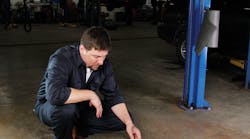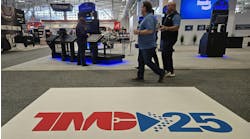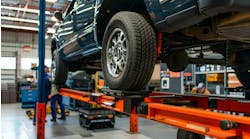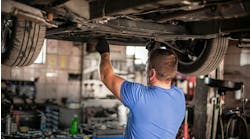Leaks and spills are an unavoidable part of some fleet maintenance procedures and operations. Being prepared to contain and clean them up quickly improves safety, protects the environment and minimizes downtime.
Two essential components to getting any job done are having the right tools and knowing how to use them. Spill containment and cleanup is no exception – and fortunately, learning to do the job right doesn’t require an extensive apprenticeship program.
GROUND RULES
Being prepared for spill containment and cleanup is a best practice that helps to ensure efficiency and promote safety. But, it also may be a regulatory requirement. The U.S. Environmental Protection Agency (EPA) requires facilities that handle hazardous wastes and large quantities of oil to have plans in place to prevent spills and to respond to spills when they do happen.
Hazardous wastes need to be managed under the Resource Conservation Recovery Act (RCRA) rules. These rules define what wastes are hazardous and list the storage and handling requirements that must be met to prevent releases or spills into the environment.
The EPA’s stormwater regulations are applicable to any facility that has the potential to discharge a pollutant into a waterway. The definition of “pollutant” is very broad and includes sediment (dirt,) detergents and even water temperature.
Like stormwater regulations, the EPA’s Spill Prevention Control and Countermeasures (SPCC) rule protects the nation’s waters from harm, but the rule specifically targets oil in any form – crude, refined, vegetable, synthetic, fuels, etc. Facilities with the capacity to store 1,320 gallons of oil above ground or 42,000 gallons under ground need to have a plan that outlines the procedures, products and practices that are in place to prevent spills, as well as the resources available to clean up spills when they do happen.
PREVENTION
A lot of focus is put on responding to spills when they happen. This is certainly essential, but if a spill can be prevented, it does not need to be cleaned up.
Preventive maintenance is a term that is often used in relation to equipment longevity. It is also a best practice that prevents spills, especially when it involves replacing hydraulic lines, pipes, hoses or anything else that moves fluids through an engine or system before they break or leak.
Likewise, routinely checking fluid storage containers for rust, weeps at seams, bulging or any other irregularity will help get faulty units repaired or replaced before they unexpectedly fail.
Another best practice for preventing spills is keeping the facility clean and orderly. Applying Lean Manufacturing principles – like getting rid of clutter, having a place for everything and keeping the workspace tidy – will help to prevent spills that are caused by inadvertently bumping, kicking or otherwise disturbing fluids that were in the way.
CONTAINMENT DEVICES
Containment devices are an additional best practice. Although they technically contain a spill instead of preventing it, they do prevent releases into aisles, work areas and the environment. Containment devices take the panic out of spill response because if the containment device is properly sized and doing its job, the spill isn’t going anywhere else.
Spill containment, sometimes called secondary containment, devices include permanent and semi-permanent berms, pallets and decks. The best form is often determined by the volume being stored.
Decks are most common for containers up to 10 gallons. Pallets are most commonly used for drum storage. Berms are most common in bulk storage, fluid dispensing and waste collection areas.
Incorporating best practices into the facility’s standard operating procedures (SOPs) can help ensure that they are not overlooked. Including them on inspection checklists is another method that can be used to verify that best practices are being used.
CLEANUP
Cleaning up small spills is almost instinctive for most adults. Who hasn’t grabbed a handful of paper towels or napkins to wipe up a spilled drink? Cleaning up spills in facilities is similar. But because some of the liquids that spill may be hazardous, a little more planning and training is needed.
Spill plans don’t need to elaborately detail every motion that will be taken or list the specifications of every item in the response kit. But, they do need to identify:
- What types of spills could happen.
- What tools and resources are available to respond to those spills.
- What steps will be taken to contain, control and clean up the spill.
Training employees to respond effectively and safely is a key component of this planning.
OSHA REGS
The Occupational Safety and Health Administration (OSHA) regulates response to emergency spills and sets training criteria for emergency responders under its Hazardous Waste Operations and Emergency Response (HAZWOPER) standard.
OSHA defines an emergency spill as one that:
- Exposes workers to high levels of toxic substances.
- Poses immediately dangerous to life and health (IDLH) conditions.
- Has a fire or explosion hazard.
- Creates an oxygen deficient atmosphere.
- Necessitates evacuation from the area.
Most spills in fixed facilities are incidental and are not governed under this standard. Training employees to respond to incidental spills can be part of hazard communication or other safety trainings.
SPILL RESPONSE TOOL SELECTION
Every spill is different, but employees should be comfortable with incidental spill response duties. Knowing how to identify what liquid has spilled, choosing appropriate personal protective equipment (PPE) and using any available spill response tools should all be incorporated into training.
When selecting spill response tools, ask employees what tools they would like to use for response. Too often, expensive spill response equipment is purchased for spill response but is never used because it is too complicated, too heavy or too awkward to use.
For most incidental spill response, a simple spill kit that includes absorbents and basic tools like a boom and dustpan or squeegees is likely to be all that is needed.
Making incidental spill response tools available in spill prone areas is a best practice that helps ensure their use. Tools that are kept in locked cabinets, in remote supply rooms or otherwise require someone to go out of their way to get them almost guarantee that a spill will be ignored instead of being cleaned up promptly.
Even with the best plans, training and tools, spills still happen. Being prepared to contain and control them quickly with the right tools and training will help avoid or minimize the chaos that sometimes accompanies response.
Karen D. Hamel, ASP (Associate Safety Professional), WACH (Walkway Auditor Certificate Holder), is an EHS (Environmental, Health & Safety) specialist and technical writer for New Pig. Since 1986, New Pig (www.newpig.com) offers a large selection of absorbent and other industrial maintenance products to help more than 200,000 industrial, commercial, grocery, military and government facilities worldwide maintain cleaner, safer, more productive work environments. Hamel has more than 22 years of experience helping EHS professionals find solutions to meet EPA, OSHA and DOT regulations. A hazmat technician, she serves on the Blair County, PA, LEPC (Local Emergency Planning Committee), is a CERT (Community Emergency Response Team) trainer and has completed a variety of environmental, safety, emergency response and NIMS (National Incident Management System) courses.



